《诊断学》课程作业习题(英文,无答案)
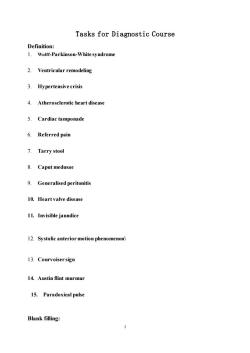
Tasks for Diagnostic Course Definition: 1.Wolff-Parkinson-White syndrome 2.Ventricular remodeling 3.Hypertensive crisis 4.Atherosclerotic heart disease 5.Cardiac tamponade 6.Referred pain 7.Tarry stool 8.Caput medusae 9.Generalised peritonitis 10.Heart valve disease 11.Invisible jaundice 12.Systolic anterior motion phenomenon 14.Austin flint murmur 15.Paradoxical pulse Blank filling:
1 Tasks for Diagnostic Course Definition: 1. Wolff-Parkinson-White syndrome 2. Ventricular remodeling 3. Hypertensive crisis 4. Atherosclerotic heart disease 5. Cardiac tamponade 6. Referred pain 7. Tarry stool 8. Caput medusae 9. Generalised peritonitis 10. Heart valve disease 11. Invisible jaundice 12. Systolic anterior motion phenomenon\ 13. Courvoiser sign 14. Austin flint murmur 15. Paradoxical pulse Blank filling:
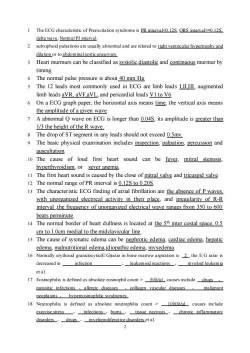
1 The ECG characteristic of Preexcitation syndrome is PRintera12 ORS intera12 delta wave.Normal PI interval subxiphoid pulsations are usually abnommal and are related to right ventricularhypertrophy and dilation or to abdominalaortic aneurysm 3 Heart murmurs can be classified as systolic,diastolic and continuous murmur by timing. 4 The normal pulse pressure is about 40 mm Hg 5 The 12 leads most commonly used in ECG are limb leads LIIIIL,augmented limb leads aVR aVE aVL,and pericardial leads V1 to V6 6 On a ECG graph paper,the horizontal axis means time,the vertical axis means the amplitude of a given wave 7 A abnormal Q wave on ECG is longer than 0.04S,its amplitude is greater than 1/3 the height of the R wave. 8 The drop of ST segment in any leads should not exceed 0.5mv. 9 The basic physical examination includes inspection,palpation,percussion and auscultation. 10 The cause of loud first heart sound can be fever,mitral stenosis hyperthyroidism,or sever anemia. 11 The first heart sound is caused by the close of mitral valve and tricuspid valve. 12 The normal range of PR interval is 0.12S to 0.20S. 13 The characteristic ECG finding of atrial fibrillation are the absence of P waves. with unorganized electrical activity in their place,and irregularity of R-R interval the frequency of unorganized electrical wave ranges from 350 to 600 beats perminute. 14 The normal border of heart dullness is located at the 5th inter costal space.0.5 cm to 1.0cm medial to the midclavicular line. 15 The cause of sysmatic edema can be nephrotic edema,cardiac edema,hepatic edema,malnutritional edema idiopathic edema,myxedema. 16 Normally erythroid granulocytic(E:G)ratio in bone marrow aspiration is2.the E:G ratiois decreased in infection 、leukemoid reactions mveloid leukemia et al 17 Eosinophilia is defined as absolute eosinophil count>500/ulcauses include drugs parasitic infections,allergic diseases collagen vasculr diseases malignant neoplasms,hypereosinophilic syndromes. 18 Neutrophilia is defined as absolute neutrophilia count>include exercise.stress 、_infections、bums、_tissue necrosis chronic inflammatory disorders drugs mveloproliferative disorders et al. 2
2 1 The ECG characteristic of Preexcitation syndrome is PR interval=0.12S, delta wave, Normal PJ interval. 2 subxiphoid pulsations are usually abnormal and are related to right ventricular hypertrophy and dilation or to abdominal aortic aneurysm. 3 Heart murmurs can be classified as systolic,diastolic and continuous murmur by timing. 4 The normal pulse pressure is about 40 mm Hg 5 The 12 leads most commonly used in ECG are limb leads I,II,III, augmented limb leads aVR, aVF,aVL, and pericardial leads V1 to V6 6 On a ECG graph paper, the horizontal axis means time, the vertical axis means the amplitude of a given wave. 7 A abnormal Q wave on ECG is longer than 0.04S, its amplitude is greater than 1/3 the height of the R wave. 8 The drop of ST segment in any leads should not exceed 0.5mv. 9 The basic physical examination includes inspection, palpation, percussion and auscultation. 10 The cause of loud first heart sound can be fever, mitral stenosis, hyperthyroidism, or sever anemia. 11 The first heart sound is caused by the close of mitral valve and tricuspid valve. 12 The normal range of PR interval is 0.12S to 0.20S. 13 The characteristic ECG finding of atrial fibrillation are the absence of P waves, with unorganized electrical activity in their place, and irregularity of R-R interval ,the frequency of unorganized electrical wave ranges from 350 to 600 beats perminute. 14 The normal border of heart dullness is located at the 5th inter costal space, 0.5 cm to 1.0cm medial to the midclavicular line. 15 The cause of sysmatic edema can be nephrotic edema, cardiac edema, hepatic edema, malnutritional edema,idiopathic edema, myxedema. 16 Normally erythroid granulocytic(E:G)ratio in bone marrow aspiration is 2 , the E:G ratio is decreased in infection 、 leukemoid reactions 、 myeloid leukemia et al. 17 Eosinophilia is defined as absolute eosinophil count > 500/ul , causes include drugs 、 parasitic infections 、allergic diseases 、collagen vascular diseases 、 malignant neoplasms 、 hypereosinophilic syndromes . 18 Neutrophilia is defined as absolute neutrophilia count > 10000/ul , causes include exercise,stress 、 infections 、burns 、 tissue necrosis 、 chronic inflammatory disorders 、 drugs 、 myeloproliferative disorders et al
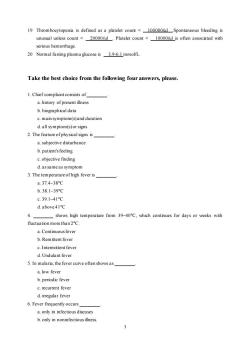
19 Thrombocytopenia is defined as a platelet count<100000/uLSpontaneous bleeding is unusual unless count<20000/uL Platelet count<10000/uLis often assocated with serious hemorrhage. 20 Normal fasting plasma glucose is39-6.1mmol/L. Take the best choice from the following four answers,please. .Chief complaint consists of a.history ofpresent illness b.biographical data c.main symptom(s)and duration d.all symptom(s)or signs 2.The featureofphysicalsigns is a.subjective disturbance b.patient's feeling c.objective finding d.assameas symptom 3.The temperatureofhigh fever is a.37.4-38℃ b.38.1-39C c.39.1-41℃ d.above41C 4. shows high temperature from 39-40C.which continues for days or weeks with fluctuation more than2C a.Continuous fever b.Remittent fever c.Intermittent feve d.Undulant fever 5.In malaria,the fever curve often shows as a.low fever b.periodic fever c.recurrent fever d.irregular fever 6.Fever frequently occurs a.only in infectious diseases b.only in noninfectious illness
3 19 Thrombocytopenia is defined as a platelet count < 100000/ul .Spontaneous bleeding is unusual unless count < 20000/ul . Platelet count < 10000/ul is often associated with serious hemorrhage. 20 Normal fasting plasma glucose is 3.9-6.1 mmol/L. Take the best choice from the following four answers, please. 1. Chief complaint consists of _. a. history of present illness b. biographical data c. main symptom(s) and duration d. all symptom(s) or signs 2. The feature of physical signs is _. a. subjective disturbance b. patient's feeling c. objective finding d. as same as symptom 3. The temperature of high fever is _. a. 37.4~38°C b. 38.1~39°C c. 39.1~41°C d. above 41°C 4. _ shows high temperature from 39~40°C, which continues for days or weeks with fluctuation more than 2°C. a. Continuous fever b. Remittent fever c. Intermittent fever d. Undulant fever 5. In malaria, the fever curve often shows as _. a. low fever b. periodic fever c. recurrent fever d. irregular fever 6. Fever frequently occurs _. a. only in infectious diseases b. only in noninfectious illness
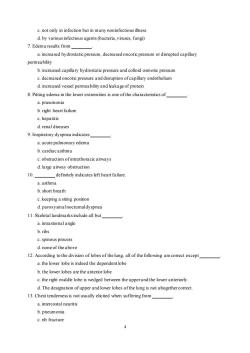
c.not only in infection but in many noninfectiousess d.by various infectious agents(bacteria,viruses,fungi) 7.Edema results from a.increased hydrostatic pressure,decreased oncoticpressure or disrupted capillary permeability b.increased capillary hydrostatic pressure and colloid osmotic pressure c.decreasedoncotic pressure and disruption of capillary endothelium d.increased vessel permeability and leakage of protein 8.Pitting edema in the lower extremities is one ofthe characteristics of a.pneumonia b.right heart failure c.hepatitis d.renaldiseases 9.Inspiratory dyspnea indicates a.acute pulmonary edema c.obstruction of intrathoracicairways d.large airway obstruction 10. definitely indicates left heart failure a asthma b.short breath c.keeping a siting position d.paroxysmalnoctumal dyspnea 11.Skeletal landmarks include all but a.intrastemalangle b.ribs c.spinous process d.none of theabove 12.According tothe division of lobes of the lung all of the following are correct except a.the lower lobe is indeed the dependent lobe b.the lower lobes are the anterior lobe c.the right middle lobe is wedged between the upperand the lower anteriorly d.The designation ofupper and lower lobes ofthe lung is not altogethercorrect 13.Chest tendemess is not usually elicited when suffering from_ b.pneumonia c.rib fracture 4
4 c. not only in infection but in many noninfectious illness d. by various infectious agents (bacteria, viruses, fungi) 7. Edema results from _. a. increased hydrostatic pressure, decreased oncotic pressure or disrupted capillary permeability b. increased capillary hydrostatic pressure and colloid osmotic pressure c. decreased oncotic pressure and disruption of capillary endothelium d. increased vessel permeability and leakage of protein 8. Pitting edema in the lower extremities is one of the characteristics of _. a. pneumonia b. right heart failure c. hepatitis d. renal diseases 9. Inspiratory dyspnea indicates _. a. acute pulmonary edema b. cardiac asthma c. obstruction of intrathoracic airways d. large airway obstruction 10. _ definitely indicates left heart failure. a. asthma b. short breath c. keeping a siting position d. paroxysmal nocturnal dyspnea 11. Skeletal landmarks include all but _. a. intrasternal angle b. ribs c. spinous process d. none of the above 12. According to the division of lobes of the lung, all of the following are correct except _. a. the lower lobe is indeed the dependent lobe b. the lower lobes are the anterior lobe c. the right middle lobe is wedged between the upper and the lower anteriorly. d. The designation of upper and lower lobes of the lung is not altogether correct. 13. Chest tenderness is not usually elicited when suffering from _. a. intercostal neuritis b. pneumonia c. rib fracture

d.cartilaginous inflammation 14.A patient tendsto breathe through pursed lips a.by doing so,he relieves a high intraluminal pressure b.by doing so,he remainsairways collapse c.it shows the patient have been in onsetof asthma d.all ofaboveare incorrect 15.Pleural rubs a.occur in late acute pleurisy with massive effusion b.are more dull in quality thanronchi c.are unaffected by cough d.are close to the earand lessened by pressure ofthe stethoscope 16.Three depression sign refers to the depression in a.the suprasternalfossae b.the supraclavicular fossae c.the intercostal space d.all ofthe above 17.Variation ofrespiratory rhythm includes a.Cheyne-Stokesrespiration b.deep-fast respiration c.Kussmauls respiration d.tachypnea 18.Vocal fremitus increases because of a.loud voice b.high pitch c.thick chest wall d.all of the above 19.Decreased orabsent vocalfremitus rarely occurs in a.emphysema b.lung consolidation c.pneumothorax. d.obstructive atelectasis 20.All of notesas follows are percussion notes except a.fremitus b.tympany c.dullness d.resonance 21.Hyperresonance is nommally caused over 5
5 d. cartilaginous inflammation 14. A patient tends to breathe through pursed lips _. a. by doing so, he relieves a high intraluminal pressure b. by doing so, he remains airways collapse c. it shows the patient have been in onset of asthma d. all of above are incorrect 15. Pleural rubs _. a. occur in late acute pleurisy with massive effusion b. are more dull in quality than ronchi c. are unaffected by cough d. are close to the ear and lessened by pressure of the stethoscope 16. Three depression sign refers to the depression in _. a. the suprasternal fossae b. the supraclavicular fossae c. the intercostal space d. all of the above 17. Variation of respiratory rhythm includes _. a. Cheyne-Stokes respiration b. deep-fast respiration c. Kussmaul's respiration d. tachypnea 18. Vocal fremitus increases because of _. a. loud voice b. high pitch c. thick chest wall d. all of the above. 19. Decreased or absent vocal fremitus rarely occurs in _. a. emphysema b. lung consolidation c. pneumothorax. d. obstructive atelectasis. 20. All of notes as follows are percussion notes except _. a. fremitus b. tympany c. dullness d. resonance 21. Hyperresonance is normally caused over _
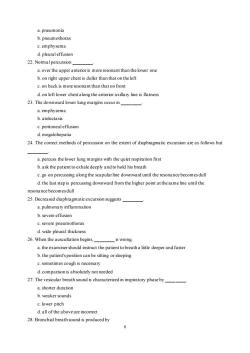
a.pneumonia b.pneumothorax c.emphysema d.pleuraleffusion 22.Nommalpercussion a.over the upper anterior is more resonant than the lower one b.on right upper chest is duller than that on the left c.on back is more resonant than that on front d.on left lower chest along the anterior axillary line is flatness 23.The downward lower lung margins occur in_ a.emphysema b.atelectasis d.megalohepatia 24.The correct methods of percussion on the extent of diaphragmatic excursion are as follows but a.percuss the lower lung margins with the quiet respiration first b.ask the patient to exhale deeply and to hold his breath e.go on percussing along the scapularline downward until the resonance becomesdull d.the last step is percussing downward from the higher point atthe same line until the resonance becomesdull 25.Decreased diaphragmatic excursion suggests a.pulmonary inflammation b.severe effusion c.severe pneumothorax d.wide pleural thickness 26.When the auscultation begins, is wrong a.the examiner should instruct the patient to breath a little deeper and faster b.the patient'sposition can be sitting or sleeping c.sometimes cough is necessary d.comparison is absolutely not needed 27.The vesicular breath sound is characterized in inspiratory phase by a.shorter duration b.weaker sounds c.lower pitch d.all of the above are incorrect 28.Bronchial breath sound is produced by 6
6 a. pneumonia b. pneumothorax c. emphysema d. pleural effusion 22. Normal percussion _. a. over the upper anterior is more resonant than the lower one b. on right upper chest is duller than that on the left c. on back is more resonant than that on front d. on left lower chest along the anterior axillary line is flatness 23. The downward lower lung margins occur in _. a. emphysema b. atelectasis c. peritoneal effusion d. megalohepatia 24. The correct methods of percussion on the extent of diaphragmatic excursion are as follows but _. a. percuss the lower lung margins with the quiet respiration first b. ask the patient to exhale deeply and to hold his breath c. go on percussing along the scapular line downward until the resonance becomes dull d. the last step is percussing downward from the higher point at the same line until the resonance becomes dull 25. Decreased diaphragmatic excursion suggests _. a. pulmonary inflammation b. severe effusion c. severe pneumothorax d. wide pleural thickness 26. When the auscultation begins, _ is wrong. a. the examiner should instruct the patient to breath a little deeper and faster b. the patient's position can be sitting or sleeping c. sometimes cough is necessary d. comparison is absolutely not needed 27. The vesicular breath sound is characterized in inspiratory phase by _ _. a. shorter duration b. weaker sounds c. lower pitch d. all of the above are incorrect 28. Bronchial breath sound is produced by
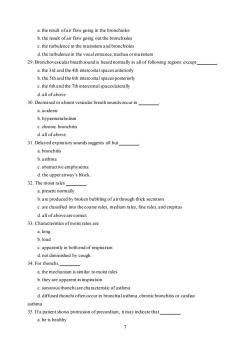
a.the result ofair flow going in the bronchioles b.the result ofair flow going out the bronchioles c.the turbulence in the mainstem and bronchioles d.the turbulence in the vocalentrance.trachea ormainstem 29.Bronchovesicularbreath sound is heard nommally in all of following regions except a.the 3rd and the 4th intercostal spacesanteriorly b.the 5thand the 6th intercostal spaces posteriorly c.the 6thand the 7th intercostal spaceslaterally d.all ofabove 30.Decreased or absent vesicular breath soundsoccur in a.acidosis b.hypermetabolism c.chronic bronchitis d.all ofabove. 31.Delayed expiratory soundssuggests all but a.bronchitis b.asthma c.obstructive emphysema d.the upperairway's block. 32.The moist rales a.present normally b.are produced by broken bubbling of air through thick secretion c.are classified into the coarse rales,medium rales,fine rales,and crepitus 33.Characteristics ofmoist rales are a.long b.loud c.apparently in bothendof respiration d.not diminished by cough 34.For rhonchi, a.the mechanism is similar to moist rales b.they are apparent in inspiration c.sonorous rhonchi are characteristic ofasthma d.diffused rhonchioftenoccur in bronchalasthma,chronic bronchitis or cardiac asthma 35.Ifa patientshows protrusion ofprecordium,it may indicate that a.he is healthy 7
7 a. the result of air flow going in the bronchioles b. the result of air flow going out the bronchioles c. the turbulence in the mainstem and bronchioles d. the turbulence in the vocal entrance, trachea or mainstem 29. Bronchovesicular breath sound is heard normally in all of following regions except _. a. the 3rd and the 4th intercostal spaces anteriorly b. the 5th and the 6th intercostal spaces posteriorly c. the 6th and the 7th intercostal spaces laterally d. all of above 30. Decreased or absent vesicular breath sounds occur in _. a. acidosis b. hypermetabolism c. chronic bronchitis d. all of above. 31. Delayed expiratory sounds suggests all but _. a. bronchitis b. asthma c. obstructive emphysema d. the upper airway's block. 32. The moist rales _. a. present normally b. are produced by broken bubbling of air through thick secretion c. are classified into the coarse rales, medium rales, fine rales, and crepitus d. all of above are correct 33. Characteristics of moist rales are a. long b. loud c. apparently in both end of respiration d. not diminished by cough. 34. For rhonchi, _. a. the mechanism is similar to moist rales b. they are apparent in inspiration c. sonorous rhonchi are characteristic of asthma d. diffused rhonchi often occur in bronchial asthma, chronic bronchitis or cardiac asthma 35. If a patient shows protrusion of precordium, it may indicate that _. a. he is healthy
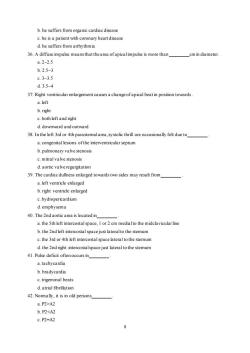
b.he suffers from organic cardiacdisease c.he is a patient with coronary heart disease d.he suffers from arhythmia 36.A diffuse impulse meansthatthe area ofapicalimpulse is more than cm in diameter a.2-2.5 b.2.5-3 c.3-3.5 d35-4 37.Right ventricular enlargement causes a change ofapical beat in position towards a.left b.right c.both left and right d.downward andoutward 38.In the left 3rd or 4th parasternalarea,systolic thrill are occasionally felt due to a.congenital lesions ofthe interventricular septum b.pulmonary valve stenosis c.mitral valve stenosis d.aortic valve regurgitation 39.The cardiac dullness enlarged towardstwo sides may result from a.left ventricle enlarged b.right ventricle enlarged c.hydropericardium d.emphysema 40.The 2ndaortic area is located in a.the 5th left intercostal space,I or 2 cm medialto the midclavicular line b.the 2nd left intercostal space just lateralto the stemum c.the 3rd or 4th left intercostal space lateral tothe stemum d.the 2nd right intercostalspace just lateral to the stemum 41.Pulse deficit oftenoccurs in a.tachycardia b.bradycardia c.trigeminal beats d.atrial fibrillatior 42.Nommally,it is in old persons a.P2>A2 b.P2<A2 c.P2=A2
8 b. he suffers from organic cardiac disease c. he is a patient with coronary heart disease d. he suffers from arrhythmia 36. A diffuse impulse means that the area of apical impulse is more than _cm in diameter. a. 2~2.5 b. 2.5~3 c. 3~3.5 d. 3.5~4 37. Right ventricular enlargement causes a change of apical beat in position towards . a. left b. right c. both left and right d. downward and outward 38. In the left 3rd or 4th parasternal area, systolic thrill are occasionally felt due to_ . a. congenital lesions of the interventricular septum b. pulmonary valve stenosis c. mitral valve stenosis d. aortic valve regurgitation 39. The cardiac dullness enlarged towards two sides may result from_ . a. left ventricle enlarged b. right ventricle enlarged c. hydropericardium d. emphysema 40. The 2nd aortic area is located in_ . a. the 5th left intercostal space, 1 or 2 cm medial to the midclavicular line b. the 2nd left intercostal space just lateral to the sternum c. the 3rd or 4th left intercostal space lateral to the sternum d. the 2nd right intercostal space just lateral to the sternum 41. Pulse deficit often occurs in_ . a. tachycardia b. bradycardia c. trigeminal beats d. atrial fibrillation 42. Normally, it is in old persons_. a. P2>A2 b. P2<A2 c. P2=A2
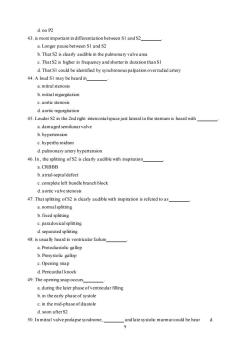
d.no p2 43.is most important in differentiation between SI and $2 a.Longer pause between SI and S2 b.That S2 is clearly audible in the pulmonary valve area c.That$2 is higher in frequency and shorter in duration thanSI d.ThatSI could be identified by synchronouspalpationoverradial artery 44.A loud SI may be heard in a.mitralstenosis b.mitral regurgitation c.aortic stenosis d.aortic regurgitation 45.Louder $2 in the 2nd right intercostalspacejust lateral to the stemum is heard with a.damaged semilunarvalve b.hypertension c.hyperthyroidism d.pulmonary artery hypertension 46.In,the splitting of $2 is clearly audible with inspiration a.CRBBB b.atrial-septaldefect c.complete left bundle branch block d.aortic valvestenosis 47.That splitting ofS2 is clearly audible with inspiration is refered to as a.nommalsplitting b.fixed splitting c.paradoxicalsplitting d.separated splitting 48.is usually heard in ventricular failure a.Protodiastolic gallop b.Presystolic gallop c.Opening snap d.Pericardial knock 49.The opening snapoccurs a.during the later phase of ventricular filling b.in the early phaseof systole c.in the mid-phase ofdiastole d.soon afterS2 50.In mitral valve prolapse syndrome and latesystolic murmurcould be hear
9 d. no P2 43. is most important in differentiation between S1 and S2_. a. Longer pause between S1 and S2 b. That S2 is clearly audible in the pulmonary valve area c. That S2 is higher in frequency and shorter in duration than S1 d. That S1 could be identified by synchronous palpation over radial artery 44. A loud S1 may be heard in_ . a. mitral stenosis b. mitral regurgitation c. aortic stenosis d. aortic regurgitation 45. Louder S2 in the 2nd right intercostal space just lateral to the sternum is heard with _. a. damaged semilunar valve b. hypertension c. hyperthyroidism d. pulmonary artery hypertension 46. In , the splitting of S2 is clearly audible with inspiration_. a. CRBBB b. atrial-septal defect c. complete left bundle branch block d. aortic valve stenosis 47. That splitting of S2 is clearly audible with inspiration is refered to as _. a. normal splitting b. fixed splitting c. paradoxical splitting d. separated splitting 48. is usually heard in ventricular failure_. a. Protodiastolic gallop b. Presystolic gallop c. Opening snap d. Pericardial knock 49. The opening snap occurs_ . a. during the later phase of ventricular filling b. in the early phase of systole c. in the mid-phase of diastole d. soon after S2 50. In mitral valve prolapse syndrome, _ and late systolic murmur could be hear d

a.summation gallop b.pericardial knock c.aortic ejection click d.middle and late systolic click 51.The mid-and late diastolic murmur caused by mitral stenosis assumea quality. a.blowing b.rumbling c.musical d.ejecting 52 loud and also accompanied by a thrill a.GradeI b.Grade II e.Grade IlI d.Grade IV 53.The murmurof mitral regurgitation may transmit with the direction a.to left axilla b.to carotid arteries c.to apex d.down along the left border ofthe stemum 54.Murmurs that originate on the right side ofthe heart frequently increase in intensity a.during expiration b.during inspiration c.during exercise d.during the change ofposition is very useful in differentiation between functionaland organic mummurs. a.The murmur found in children or youngadults b.Blowing or ejection in quality c.The murmur located in pulmonary valvearea d.The signs ofheartenlarged found 56.ln a diastolic murmur with less intense and shorter in duration,which is termed as Austin Flint murmur,could be heard in the apical are. a.mitralstenosis b.mitral regurgitation c.aortic stenosis d.aortic regurgitation 57.A soft diastolic murmur called as Graham Steel Mumur may be heard over the pulmonary valve area when exists
10 a. summation gallop b. pericardial knock c. aortic ejection click d. middle and late systolic click 51. The mid- and late diastolic murmur ca used by mitral stenosis assume a _ quality. a. blowing b. rumbling c. musical d. ejecting 52. _ murmur is quite loud and also accompanied by a thrill. a. Grade I b. Grade II c. Grade III d. Grade IV 53. The murmur of mitral regurgitation may transmit with the direction _. a. to left axilla b. to carotid arteries c. to apex d. down along the left border of the sternum 54. Murmurs that originate on the right side of the heart frequently increase in intensity _ _. a. during expiration b. during inspiration c. during exercise d. during the change of position 55. _ is very useful in differentiation between functional and organic murmurs. a. The murmur found in children or young adults b. Blowing or ejection in quality c. The murmur located in pulmonary valve area d. The signs of heart enlarged found 56. In _, a diastolic murmur with less intense and shorter in duration, which is termed as Austin Flint murmur, could be heard in the apical are. a. mitral stenosis b. mitral regurgitation c. aortic stenosis d. aortic regurgitation 57. A soft diastolic murmur called as Graham Steel Murmur may be heard over the pulmonary valve area when _ exists
按次数下载不扣除下载券;
注册用户24小时内重复下载只扣除一次;
顺序:VIP每日次数-->可用次数-->下载券;
- 《诊断学》课程作业习题(中文,部分含答案).doc
- 《诊断学》课程教学大纲(中英文双语).doc
- 重庆医科大学:《妇产科学》课程教学资源(PPT课件)29 计划生育.ppt
- 重庆医科大学:《妇产科学》课程教学资源(PPT课件)27 子宫内膜异位症.ppt
- 重庆医科大学:《妇产科学》课程教学资源(PPT课件)26 围绝经期综合征.ppt
- 重庆医科大学:《妇产科学》课程教学资源(PPT课件)25 闭经.ppt
- 重庆医科大学:《妇产科学》课程教学资源(PPT课件)24 功能失调性子宫出血.ppt
- 重庆医科大学:《妇产科学》课程教学资源(PPT课件)23 女性生殖器官损伤性疾病.ppt
- 重庆医科大学:《妇产科学》课程教学资源(PPT课件)22 妊娠滋养细胞疾病.ppt
- 重庆医科大学:《妇产科学》课程教学资源(PPT课件)21 卵巢肿瘤(ovarian tumor).ppt
- 重庆医科大学:《妇产科学》课程教学资源(PPT课件)20 子宫内膜癌.ppt
- 重庆医科大学:《妇产科学》课程教学资源(PPT课件)19 子宫肌瘤.ppt
- 重庆医科大学:《妇产科学》课程教学资源(PPT课件)17 女性生殖系统炎症.ppt
- 重庆医科大学:《妇产科学》课程教学资源(PPT课件)16 产后出血.ppt
- 重庆医科大学:《妇产科学》课程教学资源(PPT课件)15 胎儿窘迫.ppt
- 重庆医科大学:《妇产科学》课程教学资源(PPT课件)14 前置胎盘.ppt
- 重庆医科大学:《妇产科学》课程教学资源(PPT课件)12 妊娠合并急性病毒性肝炎.ppt
- 重庆医科大学:《妇产科学》课程教学资源(PPT课件)10 妊娠期肝内胆汁淤积症.ppt
- 重庆医科大学:《妇产科学》课程教学资源(PPT课件)09 妊娠合并糖尿病.ppt
- 重庆医科大学:《妇产科学》课程教学资源(PPT课件)08 妊娠合并心脏病.ppt
- 《诊断学》课程教学实验指导.pdf
- 《诊断学》课程考试试题(含参考答案).doc
- 石河子大学:《妇产科护理学》课程教学大纲 Nursing for Gynaecology and Obetetrics.pdf
- 石河子大学:《妇产科护理学》课程授课教案(负责人:张国琴).pdf
- 石河子大学:《妇产科护理学》课程教学课件(PPT讲稿)第十四章 月经失调病人的护理.ppt
- 石河子大学:《妇产科护理学》课程教学课件(PPT讲稿)第十六章 腹部手术病人的护理.ppt
- 石河子大学:《妇产科护理学》课程教学课件(PPT讲稿)第十三章 女性生殖系统炎症病人的护理.ppt
- 石河子大学:《妇产科护理学》课程教学课件(PPT讲稿)第十五章 妊娠滋养细胞疾病病人的护理.ppt
- 石河子大学:《妇产科护理学》课程教学课件(PPT讲稿)第九章 妊娠合并症妇女的护理.ppt
- 石河子大学:《妇产科护理学》课程教学课件(PPT讲稿)第十章 异常分娩妇女的护理.ppt
- 石河子大学:《妇产科护理学》课程教学课件(PPT讲稿)第十一章 分娩期并发症妇女的护理.ppt
- 石河子大学:《妇产科护理学》课程教学课件(PPT讲稿)第八章 妊娠期并发症妇女的护理.ppt
- 石河子大学:《妇产科护理学》课程教学课件(PPT讲稿)第五章 分娩期妇女的护理.ppt
- 石河子大学:《妇产科护理学》课程教学课件(PPT讲稿)第六章 产褥期管理.ppt
- 石河子大学:《妇产科护理学》课程教学课件(PPT讲稿)第一章 绪论 Obstetric and Gynecological Nursing.ppt
- 石河子大学:《妇产科护理学》课程教学课件(PPT讲稿)第二章 女性生殖系统解剖与生理.ppt
- 石河子大学:《妇产科护理学》课程教学课件(PPT讲稿)第四章 妊娠期妇女的护理.ppt
- 重庆医科大学:《实验诊断学》课程理论教学大纲(供五年制临床医学、儿科医学、预防医学、麻醉医学、影像医学专业本科使用).doc
- 重庆医科大学:《实验诊断学》课程实验教学大纲(供临床医学专业本科用).doc
- 重庆医科大学:《实验诊断学》课程教学资源(教案)第2讲 血液(下).doc
